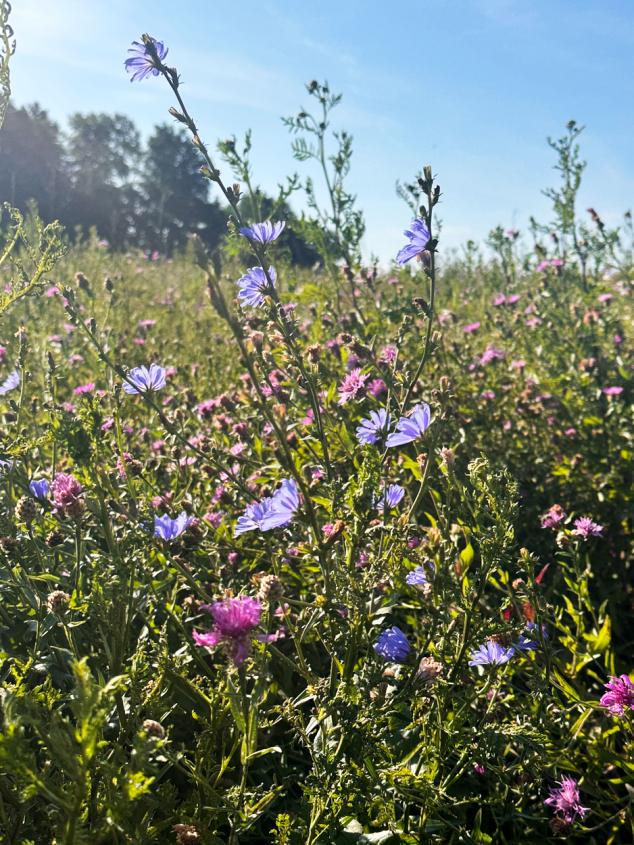Kofelder
Wildflower meadow
Originally, the idea of a wildflower meadow arose with a cooperative project, consisting of the AG Wildpflanzen-Biogas, the elobau Foundation and the Landschaftserhaltungsverband (landscape conservation society) for the district of Ravensburg. Biodiversity manager Moritz Ott from the Landschaftserhaltungsverband is delighted that these three Bodnegg companies have now taken the matter in hand independently themselves: “This is exactly the aim of our biodiversity projects: that they should be taken over and supported by the general public!”
Everything is growing and thriving on an area about the size of seven football pitches.
The colourful landscape is not just pleasing for insects, but also for people.




Wild plant field enters extra time
Update 2025
Five years of wild plant fields
How quickly time flies: our joint ‘wild plant field’ project is now in its fifth year. The average cultivation period for this annual and perennial crop is around five years – so now is a good time to admire this year's flora and take stock.
At the same time, we are delighted that the project is being extended for another five years.
Our managing director sums it up: "For us at bellissa, the wild plant field is more than just a project – it is a living symbol of biodiversity and regional solidarity. Because we have our roots in this region and are convinced that nature needs space, we are extending the project for another five years. We hope to set an example and encourage others to create habitats for animals and plants."




Spring 2025 was warm and dry – yet the fields flourished in the first few months.
From April onwards, new life sprouted from the converted fallow land, which provided valuable habitat not only for plants but also for birds and wildlife. May was sunny, but August was characterised by rain and heat, which caused some tall plants to falter.
In August, flowering is now slowly coming to an end. As in previous years, some areas are being mulched, while others remain fallow – an important retreat for animals hibernating during the winter.
Kofelder wild plant field
Update 2024
Exceptionally wet - this best describes the weather influences our wild plant field was exposed to from autumn 2023 until well into July 2024. However, this wetness has not affected the numerous perennial and native wild plants, even in their fourth year. Even though some flowers opened late due to the wet conditions, the plants themselves developed splendidly and vigorously.
Even though the weather meant that, in contrast to previous years, the wild plant field was only green and less varied in colour for a long time: It has not lost any of its beauty and habitat for insects, birds and wild animals.
Looking ahead: With the arrival of summer and dry weather, the wild plant meadow will finally become more colourful and lively in July.





Kofelder wild plant field
2023
The Kofeld wild plant field is buzzing and humming again in 2023!
With a tricky spring, the so-called third year has begun for our wild plant field.
stand year began. Weeks of rain, wet soil - the right window of opportunity to
fertilize and maintain the field was very narrow.
But those who can wait have a clear advantage: we were still able to apply lime and compost in time. As planned, we had produced the compost ourselves by mixing the chaff from the previous year's field harvest with our cattle manure and turning these masses regularly. In this way, a sensible and ecological cycle was closed directly on site. This is because the previous transport routes, such as driving the harvest to the biogas plant and bringing the fermentation residues from the biogas plant for spring fertilization, have been eliminated.
After the eternally long rainy period ended, the wild plants at the end of May
exploded overnight, so to speak.




Like last year, the red campion completely dominated the color and species
completely dominated the color and species scene on the field. In between, the white campion fought vehemently for its place. It can grow up to one meter high. Leaves and flowers are edible in salads, for example. In parallel, the knapweed in particular pushed its rosettes out of the ground.
The heat and dryness of just a few days ensured that the red and white
light carnations have already begun to fade at the beginning of June. Nevertheless, the fading red and white campion still dominate the flower picture. In the foreground, numerous knapweeds are growing up. Within a few days, the sainfoin - distributed over the whole field - appeared. With its filigree shape and delicate colors, it is a special feast for the eyes. Sainfoin has also been used as a fodder plant for horses and ruminants since time immemorial. In our fields it feeds bees and bumblebees. Meanwhile, alfalfa is also gradually establishing itself. It is now growing for the third year, which makes us very happy.
Thanks to its intensive root penetration, it not only loosens the soil, but also fixes nitrogen in it and enriches it with humus.
but also fixes nitrogen in it and enriches it with humus.
For the very first time this year we can welcome the dyer's woof. As the name
name suggests, it belongs to the so-called dyer plants. Especially animal fibers
such as wool, silk and linen are suitable to be dyed with the above-ground parts of the plant.
to be dyed. The plant can also be used to produce lightfast painter's dye.
can be made. Wild bees and butterflies love it.
Wild carrots appear sporadically, but not in such large numbers as last year for a long time.
Text and photo: Katharina Stohr
